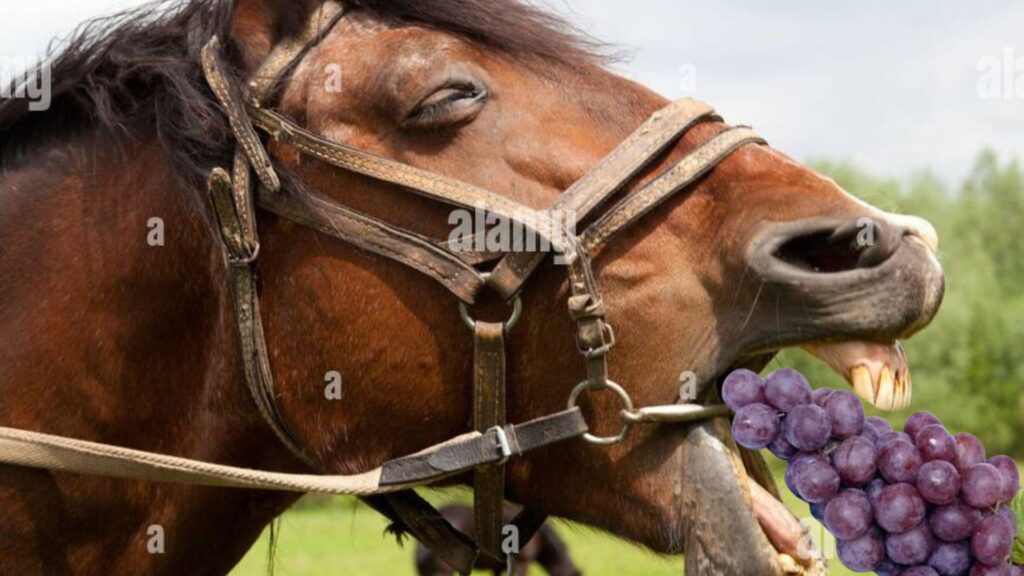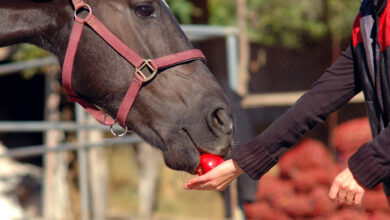
Horses hold a special place in our hearts. We want to shower them with treats and rewards for their companionship and hard work.
But when it comes to feeding treats, it’s important to make sure they are safe for your horse’s health. One popular question many horse owners have is: can I feed my horse grapes?
Let’s take a look at the facts.
Grapes are a refreshing, sweet fruit that humans have been enjoying for thousands of years. But just because we love grapes, does it mean our four-legged friends can safely eat them too?
So, can horses eat grapes? The short answer is yes, horses can eat grapes in moderation as an occasional treat.
Are Grapes Safe or Toxic for Horses?
Grapes are not inherently toxic to horses, but they do need to be fed carefully and in small amounts. The main concern with grapes is their high natural sugar content.
If a horse consumes too many grapes at one time,

it could lead to digestive upset like colic or diarrhea. The acidic nature of grapes could also cause problems like mouth sores or canker sores when overeaten.
According to veterinarian Dr. Sarah Gold of Equine Wellness Clinic, “Grapes have a high glycemic index, meaning they cause blood sugar and insulin to spike rapidly. For horses prone to laminitis or insulin resistance, grapes could exacerbate these conditions.”
While grapes are not recommended as a regular part of a horse’s diet, most horses can safely enjoy a few grapes one or two times per week without issue.
Monitor your horse when introducing grapes and adjust serving sizes based on their individual reaction.
What Parts of Grapes Can Horses Eat?
Grapes don’t need much prep work before serving them to your horse. Horses can eat grapes whole with the skin, flesh and seeds all intact. It’s fine for horses to consume the entire grape.
However, there are some grape-related foods you’ll want to avoid:
- Raisins or dried grapes have an even higher sugar concentration.
- Grape stems, and leaves contain toxic compounds and should not be eaten.
Read More: Can Horses Eat Strawberries?
Can Horses Eat Grapes? Nutritional Value
In small amounts, grapes can provide some nutritional value for horses:
- High in vitamin C, vitamin K, and antioxidants
- Good source of potassium, copper, and manganese
- Mostly natural sugars and carbohydrates, not much protein
Grapes serve more purpose as a treat for horses rather than as a major component of their daily diet. Enjoy grapes as the special snack they are!
Grape Varietals – Which are Best for Horses?
Not all grapes are created equal when it comes to equine treats. Some varieties are safer and more nutritious for horses than others.
Seedless grapes are a better choice than grapes with seeds, which could potentially cause intestinal upset if a large quantity of seeds is consumed.
The fleshy part of the grape is what horses can most easily digest and benefit from nutritionally.
Of the common red and green grape varietals, nutritionists recommend red or green grapes over purple grapes.
Concord grapes, in particular, have an especially high sugar content and have been linked to toxicity in horses when overeating.
According to a study in the Journal of Equine Veterinary Science, grapes had a moderate glycemic and insulin index compared to other high-sugar feeds.
However, this study did note that overconsumption of grapes could still pose a risk for laminitis-prone horses. Moderation is key.
Recommended Serving Size of Grapes for Horses
When feeding grapes, it’s important to limit portion sizes:
- No more than 1-2 ounces or 1-4 grapes just once or twice per week
- For a 1,000 lb. horse, 4-8 grapes are a good serving size
Of course, the exact amount varies on the individual horse. Introduce grapes slowly and watch for any signs of digestive upset or diarrhea, adjusting amounts downward if needed.
Potential Risks & Dangers of Feeding Grapes to Horses
While grapes are not toxic to horses, there are some potential downsides of overfeeding them:
- Too many grapes could lead to colic, diarrhea, or other digestive issues
- The high sugar and acidity are problematic for horses’ long-term
- It can cause mouth sores, irritation, or canker sores
- Increased risk of laminitis in horses prone to hoof problems
That’s why it’s critical to stick to the recommended 1-4 grape serving size per thousand pounds of body weight and limit grapes to an occasional treat.
Tips for Safely Feeding Grapes to Horses
Follow these tips for safely incorporating grapes into your horse’s diet:
- Wash grapes thoroughly before feeding to remove any pesticides
- Cut any large grapes into small pieces for easier chewing and digestion
- Avoid raisins, dried grapes, or grape plants entirely
- Slowly introduce grapes in small amounts and monitor the horse’s reaction
- Do not replace main hay/grain meals with grapes
By following these best practices, you and your horse can safely enjoy the occasional grape treat!
What About Raisins, Currants, and Other Dried Grapes?
It’s best to avoid feeding horses raisins, currants, sultanas, or other dried grape products. The drying process concentrates the sugars and makes these treats too high risk.
A one-ounce box of raisins can have up to 30 grams of sugar – more than most horses should consume in a day! Needless to say, raisins and dried grapes are not recommended horse treats.
If you do wish to share a few dried grapes, make sure to soak them in water first to extract some of the excess sugars. Limit-soaked raisins to 1-2 very small servings per day maximum.
Can Horses Eat Grape Juice?
Like dried grapes, grape juice is not an ideal equine treat due to its extremely high sugar content. Drinking large amounts of grape juice could lead to obesity, insulin resistance, metabolic disorders or laminitis.
In moderation, a few ounces of diluted grape juice can be safe as a rare treat. Dilute juice with at least 4-5 parts water. For an average-sized horse, 1-2 ounces of diluted grape juice once in a while is the recommended portion.
How to Serve Grapes as a Treat for Horses
When feeding grapes, follow these steps:
- Only provide 1-4 grapes per serving
- Hold grapes in the palm of your hand for your horse to eat
- Never feed grapes directly off the ground or in the feed bucket
- Monitor consumption and end the treat portion after 1-4 grapes
Grapes don’t necessarily need to be cut or sliced unless they are very large. Just be sure to wash them thoroughly and hold them flat in your palm when hand-feeding.
Make grapes a part of positive reinforcement during training versus dumping them in a feed bucket.
Nutritional Comparison of Grapes & Other Common Horse Treats
| Treat | Calories | Sugar | Vitamin C |
| Grapes | 62 per ounce | 15g | 10% DV |
| Apple | 65 per medium | 19g | 8% DV |
| Carrot | 30 per medium | 4g | 10% DV |
| Peppermint | 25 per piece | 3g | 0% DV |
What to Do if a Horse Eats Too Many Grapes
If your horse accidentally consumes a large number of grapes, here’s what to do:
- Withhold food and provide ample water
- Call the vet if signs of colic, diarrhea, or distress
- IV fluids, electrolytes, and pain relief, may be needed
- Keep the horse moving to prevent laminitis
- Monitor vitals, gut sounds, and behavior closely
- Adjust grape intake based on reactions
By quickly responding and contacting your vet, most horses recover fully from overeating grapes. Slowly re-introduce grapes in smaller portions if desired.
The Verdict?
Can horses eat grapes? In moderation, yes! But limit grapes to an occasional treat. Avoid raisins and dried grapes, which are too high in sugar. By following proper feeding guidelines, grapes can be part of a healthy, balanced equine diet.



